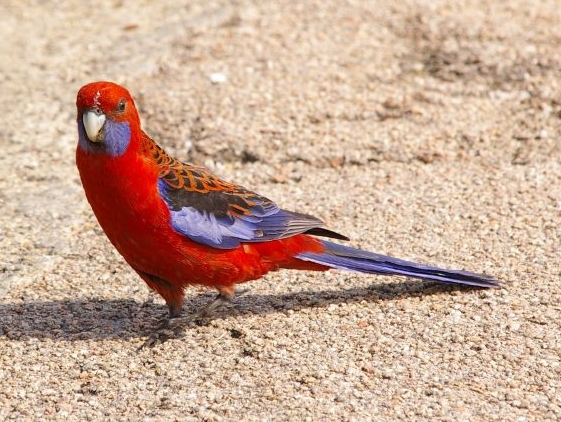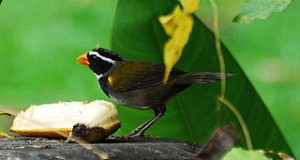 Crimson rosellas, colorful parrots much favored as pets, follow a unique strategy when rearing their young.
Crimson rosellas, colorful parrots much favored as pets, follow a unique strategy when rearing their young.
The Typical Scenario
Rosella eggs, like those of all parrots, hatch in the order they were laid, so that the first chick to emerge has a few days head-start on the last. In most bird species where this occurs, the first chick out of the egg out-competes the others, as parents tend to feed the largest, noisiest mouth that confronts them. This assures that, in times of food scarcity, at least one chick may survive, albeit at the expense of the others.
A Twist – Choosing Which Chick Will be Fed
I recently watched some footage that indicated that adult crimson rosellas apportion food given to chicks equally, so that all survive and fledge at about the same size. Upon considering this, I found it odd, as rosellas inhabit a harsh environment, where food shortages are likely, and so “should”, I reasoned, put the most resources into the largest chick.
Further research revealed that the complete story is even more surprising. Male and female rosella parents specifically identify individual chicks and selectively choose which to feed, based on varying criteria.
Males respond to the chick that seems hungriest at the time, as indicated by the volume of its call. Thus, males tend to distribute food equally among the brood…a sated chick becomes quiet, and another is fed. Females preferentially feed the last-hatched (smallest) chick…unless all are crying out for food, in which case they feed the oldest (largest) chick first.
Outcome in Good and Bad Times
In good times, this strategy assures that the youngest chick is well fed, and that all receive enough food. When food is scarce, however, and all chicks are hungry, the oldest will be fed more often by both the male (this chick will attract the male by its ability to beg more vigorously) and female. The elder chick is, therefore, only granted a survival advantage during lean years…when food is plentiful, all chicks are assured a good diet and an equal chance at fledging.
Rosella chicks have also been observed sharing food among themselves… more on that in the future.
A report concerning the Australia National University study that documented this behavior is posted at:
http://www.anu.edu.au/BoZo/magrath/pdfs/paper4.pdf
Image referenced from Wikipedia, and originally posted by Percita Dittmar
 That Bird Blog – Bird Care and History for Pet Birds
That Bird Blog – Bird Care and History for Pet Birds



Very usefull post.
Thanks.
P.S. I like your writing style.
Hello Tom,
Frank Indiviglio here. Thanks so much for your kind remark. I’m particularly pleased as regards this one because I enjoy adding research updates, but worry that people might prefer practical articles.
I’ll add similar ones from time to time; please be in touch if I can be of any help.
Best regards, Frank Indiviglio.
First of all congratulation for such a great site. I learned a lot reading article here today. I will make sure i visit this site once a day so i can learn more.
Hello, Frank Indiviglio here.
Thanks for your interest in our blog, and for taking the time to write in. Your kind words are much appreciated. Any feedback, questions or thoughts concerning articles that you’d like to read would be most welcome.
Best regards, Frank Indiviglio.
I recently stayed on a bush property where the owner had made bird boxes specifically to attract native birds. A pair of Crimson Rosellas had nested in one of the boxes and after observing them for a few days finally got to see the chicks come up to the hole – just gorgeous! We were priviledged to spend a few days being able to watch these chicks (2 of them) grow bigger, stronger and more curious about the big wild world every day. Unfortunately the chicks fledged when their parents were not around. We assumed this because one day they had disappeared but the parents continued to come back every day for days afterwards looking for them – it was the most heartbreaking thing I’ve ever seen. Do you have any idea what the chances of survival for the chicks would have been?
Hello, Frank Indiviglio here. Thanks for your interest in our blog.
Thanks very much for the story…sitting here in frigid NY, I’d give anything to be able to see rosellas in my back yard!
Fledglings of all species nearly always leave the nest before being able to fly well, and a great many are caught by predators in the first few days thereafter. However, because of their “equitable” feeding strategy, rosella chicks are usually in better shape than most other species, and have a better chance at making it. The fact that there were only 2 chicks is very much in their favor. Two is a small clutch, so the chicks most likely were well-fed and stronger than average upon fledging.
As for the parents seeming to search for the chicks, that’s very odd…usually fledglings are easy to locate, as they cannot go far (in some species the chicks are fed for a few days after fledging). Perhaps these were good fliers right out of the nest, which again would work in their favor. Another possibility is that a snake, lizard or small mammal moved into the nest box once it was empty, and the parents were making a fuss over that. Whatever the outcome, I think all went as well as could be, and you were very fortunate to have been able to see it up close.
Best regards, Frank Indiviglio.
Thought you might be interested in this: http://www.sciencedirect.com/science?_ob=ArticleURL&_udi=B6W9W-45HR871-2T&_user=10&_rdoc=1&_fmt=&_orig=search&_sort=d&view=c&_acct=C000050221&_version=1&_urlVersion=0&_userid=10&md5=5b356c346b8f4abdd7cabc361ca9c402
Sue H
Hello Sue, Frank Indiviglio here. Thanks for your interest in our blog and for the reference to a most interesting article. It shows that rosella chick feeding strategies are even more complex than originally believed.
I don’t know of any other bird that apportions food among chicks in such a manner. I’ve watched a number of nests of other birds fairly closely (in zoo collections) and it seems that the biggest and largest mouth gets the most food.
In fact, sometimes any large mouth will do – I was once shown a photo of a robin stuffing an earthworm into the mouth of a fish (a koi that had surfaced near when the robin was foraging)!
Always pleased to receive interesting news, thanks very much…
Best regards, Frank Indiviglio.
Yes has had fun reading your comments, on such serious theme
http://anekdot-vip.ru
Hello, Frank Indiviglio here.
Thanks for your interest in our blog, and for taking the time to write in with your kind comment.
If you are interested, I have written other articles on similar themes, including Stress and Finch Nestlings and Colorful Finch Chick Mouths. Hope you enjoy!
Best regards, Frank Indiviglio.